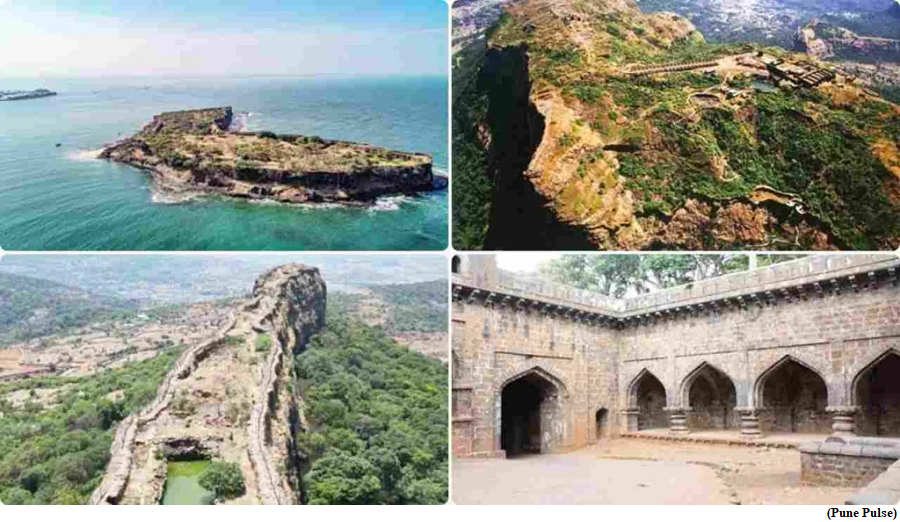Maratha Military Landscapes of India nominated for recognition as UNESCO World Heritage List 2024-25 (GS Paper 1, Culture)

Why in news?
- The “Maratha Military Landscapes of India” is India’s nomination for recognition as UNESCO World Heritage List for the year 2024-25.
Components:
- The twelve component parts of this nomination are, Salher fort, Shivneri fort, Lohgad, Khanderi fort, Raigad, Rajgad, Pratapgad, Suvarnadurg, Panhala Fort, Vijay durg, Sindhudurg in Maharashtra and Gingee Fort in Tamil Nadu.
- These components, distributed across diverse geographical and physiographic regions, showcase the strategic military powers of the Maratha rule.
About Maratha Military Landscapes of India:
- The Maratha Military Landscapes of India, which developed between 17th and 19th centuries, represent an extraordinary fortification and military system envisioned by the Maratha rulers.
- This extraordinary network of forts, varying in hierarchies, scales and typological features, is a result of integrating the landscape, terrain and physiographic characteristics distinctive to the Sahyadri mountain ranges, the Konkan Coast, Deccan Plateau and the Eastern Ghats in the Indian Peninsula.
- There are more than 390 forts in Maharashtra out of which only 12 forts are selected under the Maratha Military Landscapes of India, of these eight forts are protected by the Archaeological Survey of India.
- These are Shivneri fort, Lohgad, Raigad, Suvarnadurg, Panhala fort, Vijaydurg, Sindhudurg and Gingee fort whereas Salher fort, Rajgad, Khanderi fort and Pratapgarh are protected by the Directorate of Archaeology and Museums, Government of Maharashtra. In the Maratha Military Landscapes of India Salher fort, Shivneri fort, Lohgad, Raigad, Rajgad and Gingee fort are hill forts, Pratapgad is hill-forest fort, Panhala is hill-plateau fort, Vijaydurg is coastal fort whereas Khanderi fort, Suvarnadurg and Sindhudurg are island forts.
- The inception of the Maratha Military ideology dates back to 17th Century during the reign of the Maratha King Chhatrapati Shivaji Maharaj by the 1670 CE and continued through subsequent rules until Peshwa rule till 1818 CE.
Criterion:
- There are two categories of nomination- cultural and natural criteria, the Maratha Military landscapes is nominated in the category of cultural criteria.
- There are six criteria (i to vi) for cultural sites and four criteria (vii to x) for natural sites for inclusion in the World Heritage List.
The Maratha Military Landscapes of India is nominated under
- Criterion (iii): To bear a unique or at least exceptional testimony to a cultural tradition or to a civilization that in living or which has disappeared,
- Criterion (iv): to be an outstanding example of a type of building, architectural or technological ensemble, or landscape that illustrates significant stage(s) in human history and
- Criterion (vi): To be directly or tangibly associated with events or living traditions, with ideas or with beliefs, with artistic and literary works of outstanding universal significance.
World Heritage sites in India:
- At present in India there are 42 World Heritage sites, out of which 34 are cultural sites, seven are natural sites whereas one is mixed site.
- In Maharashtra there are six World Heritage Sites, five cultural and one natural these are, Ajanta Caves (1983), Ellora Caves (1983), Elephanta Caves (1987), Chhatrapati Shivaji Maharaj Terminus (formerly Victoria Terminus) (2004), Victorian Gothic and Art Deco Ensembles of Mumbai (2018) and western Ghats of Maharashtra, Karnataka, Tamil Nadu and Kerala is serial property in natural category (2012).
- The Maratha Military Landscapes of India included in the Tentative List of World Heritage sites in 2021 is the sixth cultural property nominated for inclusion in the World Heritage List from Maharashtra.
Exercise Sada Tanseeq
(GS Paper 3, Defence)
Why in news?
- The inaugural edition of India-Saudi Arabia Joint Military Exercise ‘SADA TANSEEQ’ commenced recently at Mahajan, Rajasthan.
- The Exercise is scheduled to be conducted from 29th January to 10th February 2024.

Aim:
- Aim of the Exercise is to train troops of both sides for Joint Operations in Semi Desert terrain under Chapter VII of the United Nations Charter.
Key Highlights:
- The Exercise will enable both the sides to share their best practices in the tactics, techniques and procedures of conducting operations in sub-conventional domain.
- It will facilitate developing interoperability, bonhomie and camaraderie between troops from both the sides.
- The Exercise will involve Establishment of Mobile Vehicle Check Post, Cordon & Search Operation, House Intervention Drill, Reflex Shooting, Slithering and Sniper Firing. The Exercise will provide an opportunity to both the contingents to strengthen their bond.
Way Forward:
- It will act as a platform to achieve shared security objectives, enhance the level of defence cooperation and foster bilateral relations between the two friendly nations.



